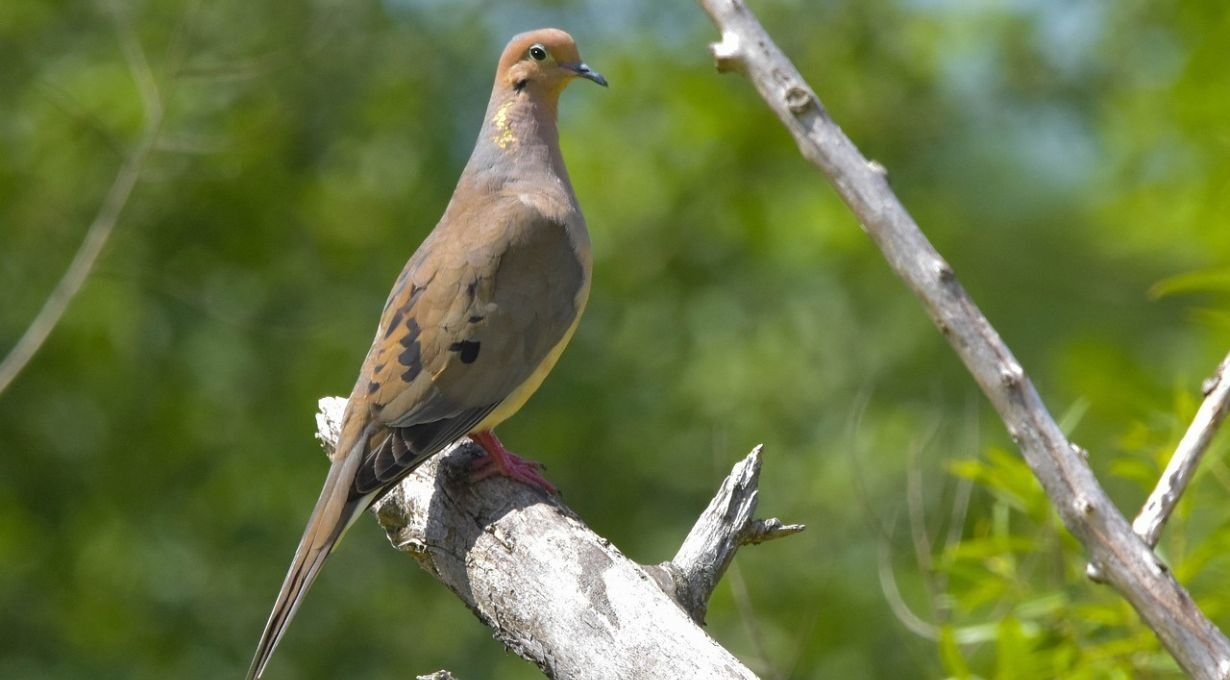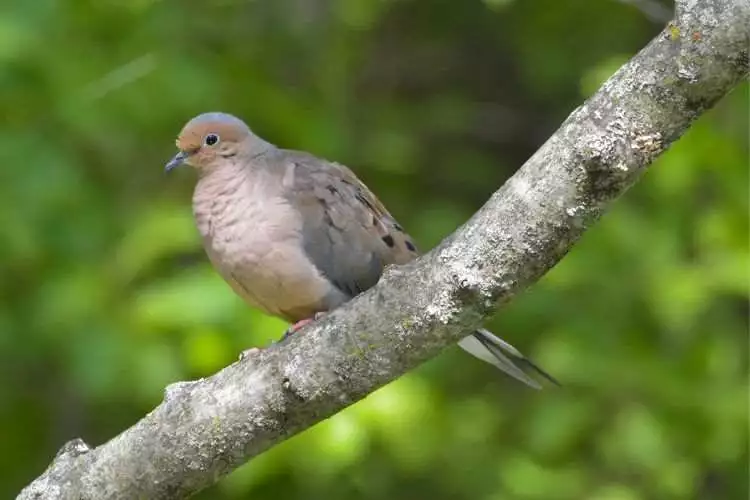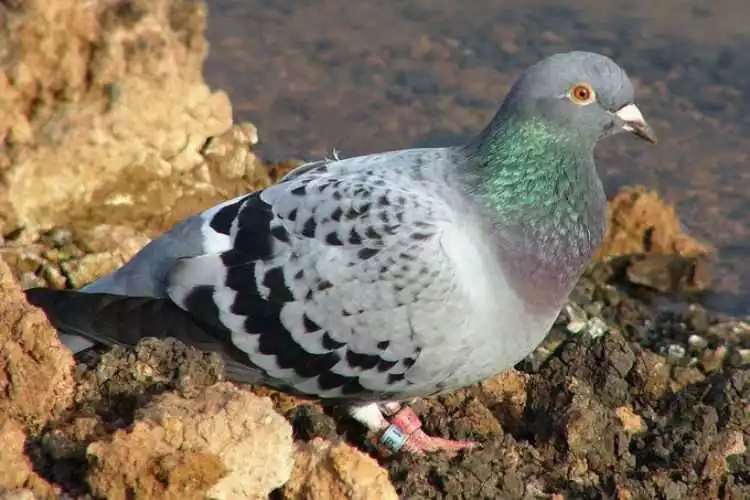
Doves are a type of bird that is known for their gentle nature and beautiful cooing sound. There are two types of doves in Maine: the Mourning Dove and the Rock Pigeon.
Where to see doves in Maine
Mourning Doves can be seen all over Maine, but they are most common in southern and coastal areas.
They are often seen in backyards, fields, and forests. Rock Pigeons are most common in urban and suburban areas, where they can be seen in parks, plazas, and rooftops.
Mourning Dove in Maine

Mourning Doves are common doves in Maine. They are medium-sized with grayish-brown feathers and a bit of pink on their chests. You might notice their long, pointed tails. They mainly eat seeds, grains, and small bugs.
Habitat
Mourning Doves in Maine can be found in a variety of habitats, including open fields, gardens, farmlands, woodlands, and even suburban areas.
They are quite adaptable and can thrive in both rural and urban environments. You can also see these doves in Florida.
Size:
Mourning Doves are medium-sized birds, typically measuring about 9-13 inches (23-33 cm) in length, with a wingspan of 17-18 inches (42-47 cm).
Color and Identifying Features:
- Their overall color is pale grayish-brown with a slightly pinkish hue on the chest.
- They have long, pointed tails.
- A distinguishing feature is the black crescent-shaped mark on the sides of their neck, which can sometimes be challenging to see.
Food
Mourning Doves primarily feed on seeds and grains, such as those from grasses, and weeds, and cultivated crops like sunflower seeds.
They will also eat small insects when available. They are often seen foraging on the ground for food. These species of doves in Hawaii also eat different types of seeds.
Behavior:
- Mourning Doves are known for their soft and mournful cooing calls, which they use for communication, especially during courtship.
- They are ground feeders and are often seen pecking for seeds on the ground or visiting bird feeders.
- These doves are generally gentle and peaceful birds and are not aggressive towards other birds.
Where to See in Maine
You can spot Mourning Doves throughout Maine, but they are most commonly found in open areas like fields, meadows, and agricultural lands.
They also frequent suburban and urban neighborhoods, so you may see them in your backyard if you provide a suitable feeding area.
Interesting Facts:
- Mourning Doves are among the most widespread and abundant bird species in North America.
- They are migratory birds and may move south during the winter, but many stay in Maine year-round.
- Mourning Doves are known for their rapid and acrobatic flight patterns, with wing whistling sounds as they take off and land.
- They are monogamous birds, and pairs often stay together throughout the breeding season.
- In some Native American cultures, the Mourning Dove symbolizes peace and love.
Observing Mourning Doves in Maine can be a rewarding experience due to their gentle nature and distinctive cooing calls.
You can attract them to your backyard by providing food in bird feeders, creating an opportunity to enjoy their presence up close.
Rock Dove in Maine

Rock Doves, also known as Rock Pigeons, are indeed present in Maine, especially in urban and suburban areas. Here’s straightforward information about them:
Habitat
Rock Doves adapt well to urban and suburban environments, often roosting on buildings and bridges. These Rock Pigeons are also common doves in Arizona.
Size and Appearance:
- They are medium-sized birds, about 11-14 inches long with a wingspan of 17-19 inches.
- They have bluish-gray feathers, a white rump, two dark wing bars, and a dark tail band.
- Pink legs and bright red eyes are distinctive features.
Food
Rock Doves mainly eat seeds, grains, and human food scraps, often foraging in public spaces.
Behavior:
- These social birds are often found in flocks, especially in cities.
- Recognizable by their cooing calls, common near roosting sites.
- Strong fliers, covering long distances for food.
Where to See in Maine
Find Rock Doves in Maine’s urban and suburban areas, near buildings, parks, and coastal towns. You can also find these Doves in Michigan.
Interesting Facts:
- Rock Doves are domesticated descendants of wild Rock Doves, also known as homing pigeons.
- Highly adaptable, they’ve colonized cities worldwide.
- Known for their homing ability, studied for centuries.
Rock Doves are a common sight in Maine’s urban areas, easily recognizable due to their distinctive appearance and behaviors. While they might not be as celebrated as other birds, they are an essential part of the state’s birdlife.
How to attract doves to your backyard
To attract doves to your backyard, you can create an inviting environment that provides food and shelter for these birds. Here are some detailed steps to attract doves:
- Choose the Right Feeder: Pick a flat, ground-level bird feeder. Doves like to feed on open surfaces.
- Seed Selection: Use a mix of sunflower seeds, millet, and cracked corn. These are Dove’s favorite snacks.
- Feeder Placement: Put the feeder in a quiet spot with nearby plants or trees for cover. Doves feel safer when they have a quick escape nearby.
- Ground Feeding: Scatter some seeds on the ground under the feeder; doves are natural ground feeders.
- Water Source: Set up a birdbath or shallow water dish for them to drink and bathe.
- Native Plants: Grow native plants like blackberries, raspberries, and pokeberries in your yard. They produce seeds doves love.
- No Pesticides: Avoid harmful chemicals like pesticides to keep the environment safe for doves.
- Be Patient: It might take a while for doves to find your feeder. Keep providing food regularly.
- Clean Feeder: Keep the feeder tidy, and refill it often.
- Observe Quietly: Once doves start coming, watch them quietly from a distance.
By following these simple steps, you can create an inviting space for doves in your backyard, making it a peaceful and enjoyable place for both you and the birds.
Conclusion
In summary, Maine is home to various dove species, with the Mourning Dove being the most common. These peaceful, grayish-brown birds are adaptable and found in many places, from rural areas to suburbs. Although less common, you might also encounter species like the Rock Dove, White-winged Dove, and Eurasian collared dove in Maine.
To attract and enjoy doves in your area, consider setting up bird feeders with seeds and planting dove-friendly native plants. Whether in your backyard or while exploring Maine’s landscapes, observing these gentle birds can be a calming and enjoyable experience.

